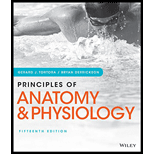
Which components of the
To review:
The gastrointestinal (GI) tract organs as well as accessory digestive organs.
Introduction:
Digestion is the process, by which the larger food particles are broken down into smaller absorbable molecules. This system consists of GI tract (alimentary canal) and the accessory organs.
Explanation of Solution
The digestive system is divided into two major subdivisions:
GI tract
Accessory organs
The organs of the alimentary canal are pharynx, mouth, stomach, esophagus, and small as well as large intestines. The GI tract is a long tube-like structure that spans from the mouth up to the anus. The accessory digestive organs include the salivary glands, teeth, gallbladder, tongue, pancreas, and liver. The functions of different digestive system's organs are described below:
The mouth is the opening of the alimentary canal. Food enters the digestive tract via the mouth. Mouth consists of the salivary glands, teeth, and the tongue. Salivary glands secrete saliva that helps in the digestion of carbohydrates. Teeth and tongue help in the mastication of food. Then the food goes into the esophagus, through which the food enters the stomach. Peristaltic movements (rhythmic contractions and relaxations) in the esophagus enable food to move into the stomach.
The stomach is a muscular bag, which is involved in the hydrolysis of protein. It releases pepsin for protein digestion and also secretes hydrochloric acid to make the food acidic so that the intestinal enzymes can act on it.
The small intestine is where the digestion ends. It has three subdivisions namely, duodenum followed by jejunum and lastly the ileum. It receives secretions from the liver and the pancreas that digest the food further. This is where the food components are absorbed via the villi in the small intestine.
The large intestine is usually involved in the absorption of water and nutrients by the body. The subdivisions of the large intestine are rectum, cecum, colon, anal canal, and appendix. Other digestive organs include pancreas, gallbladder, and liver.
Thus, the different digestive organs include organs of the alimentary canal and the accessory organs. These organs work together to break down the large food particles into smaller absorbable molecules. These molecules are then absorbed in the blood and thus, the energy and nutrition are supplied to different body tissues.
Want to see more full solutions like this?
Chapter 24 Solutions
Principles of Anatomy and Physiology
Additional Science Textbook Solutions
Genetics: From Genes to Genomes
Applications and Investigations in Earth Science (9th Edition)
Campbell Essential Biology (7th Edition)
Laboratory Manual For Human Anatomy & Physiology
- In one paragraph show how atoms and they're structure are related to the structure of dna and proteins. Talk about what atoms are. what they're made of, why chemical bonding is important to DNA?arrow_forwardWhat are the structure and properties of atoms and chemical bonds (especially how they relate to DNA and proteins).arrow_forwardThe Sentinel Cell: Nature’s Answer to Cancer?arrow_forward
- Molecular Biology Question You are working to characterize a novel protein in mice. Analysis shows that high levels of the primary transcript that codes for this protein are found in tissue from the brain, muscle, liver, and pancreas. However, an antibody that recognizes the C-terminal portion of the protein indicates that the protein is present in brain, muscle, and liver, but not in the pancreas. What is the most likely explanation for this result?arrow_forwardMolecular Biology Explain/discuss how “slow stop” and “quick/fast stop” mutants wereused to identify different protein involved in DNA replication in E. coli.arrow_forwardMolecular Biology Question A gene that codes for a protein was removed from a eukaryotic cell and inserted into a prokaryotic cell. Although the gene was successfully transcribed and translated, it produced a different protein than it produced in the eukaryotic cell. What is the most likely explanation?arrow_forward
- Molecular Biology LIST three characteristics of origins of replicationarrow_forwardMolecular Biology Question Please help. Thank you For E coli DNA polymerase III, give the structure and function of the b-clamp sub-complex. Describe how the structure of this sub-complex is important for it’s function.arrow_forwardMolecular Biology LIST three characteristics of DNA Polymerasesarrow_forward
 Human Physiology: From Cells to Systems (MindTap ...BiologyISBN:9781285866932Author:Lauralee SherwoodPublisher:Cengage Learning
Human Physiology: From Cells to Systems (MindTap ...BiologyISBN:9781285866932Author:Lauralee SherwoodPublisher:Cengage Learning Human Biology (MindTap Course List)BiologyISBN:9781305112100Author:Cecie Starr, Beverly McMillanPublisher:Cengage Learning
Human Biology (MindTap Course List)BiologyISBN:9781305112100Author:Cecie Starr, Beverly McMillanPublisher:Cengage Learning Concepts of BiologyBiologyISBN:9781938168116Author:Samantha Fowler, Rebecca Roush, James WisePublisher:OpenStax College
Concepts of BiologyBiologyISBN:9781938168116Author:Samantha Fowler, Rebecca Roush, James WisePublisher:OpenStax College





